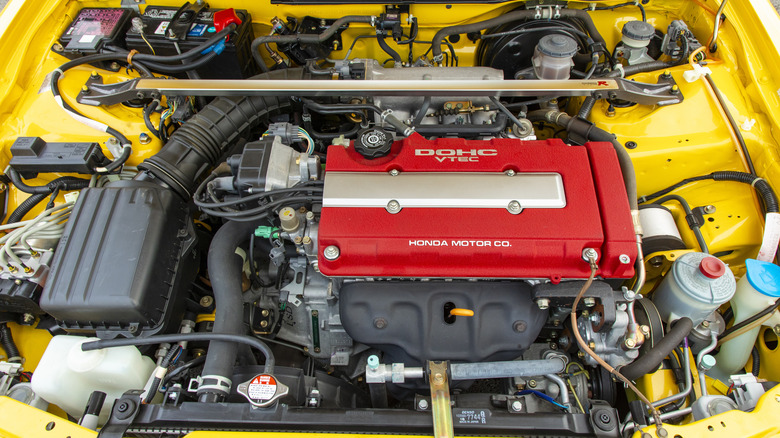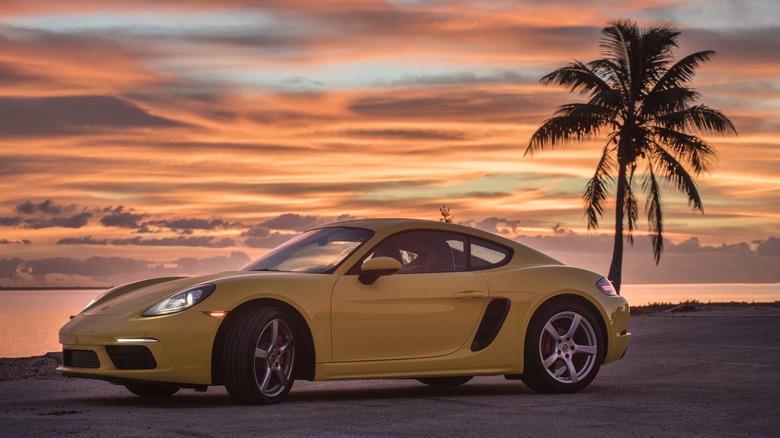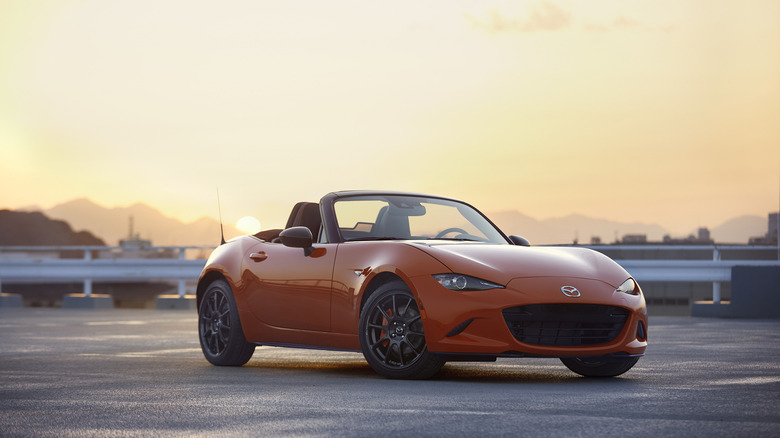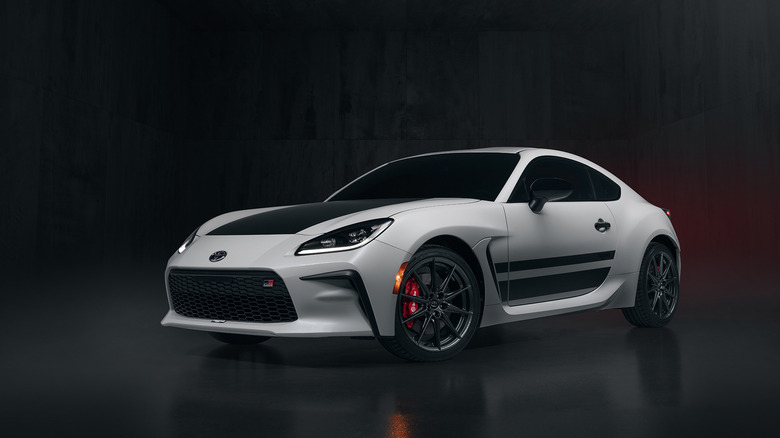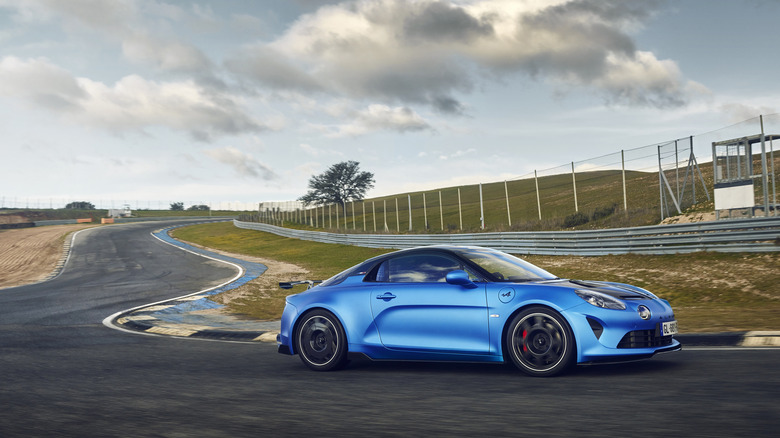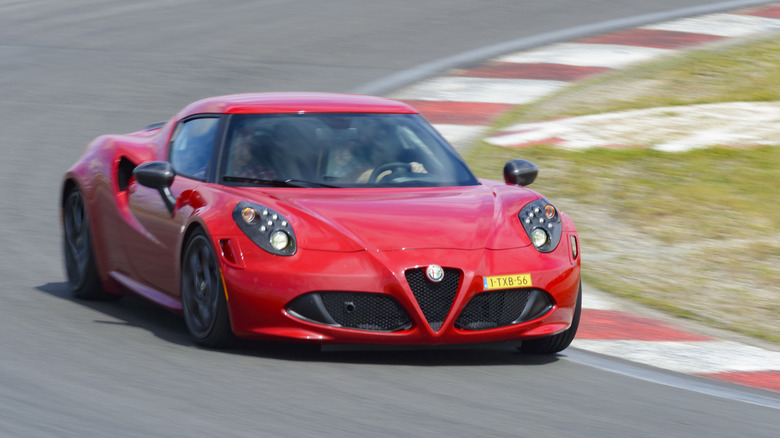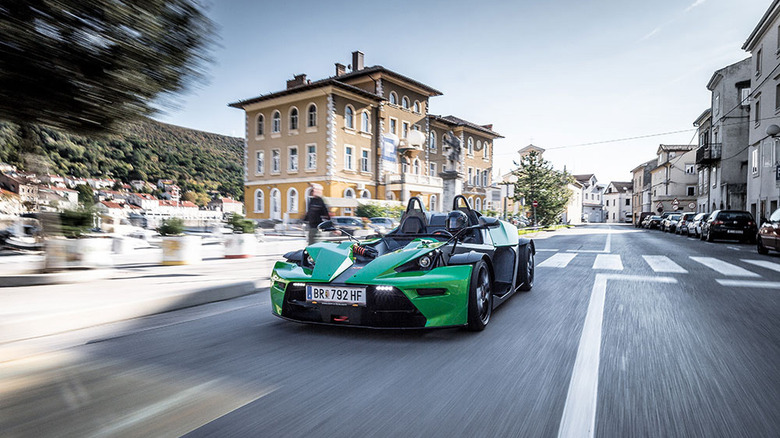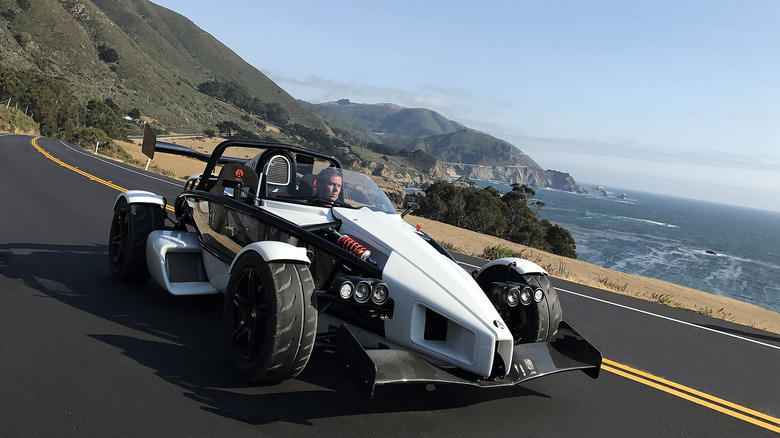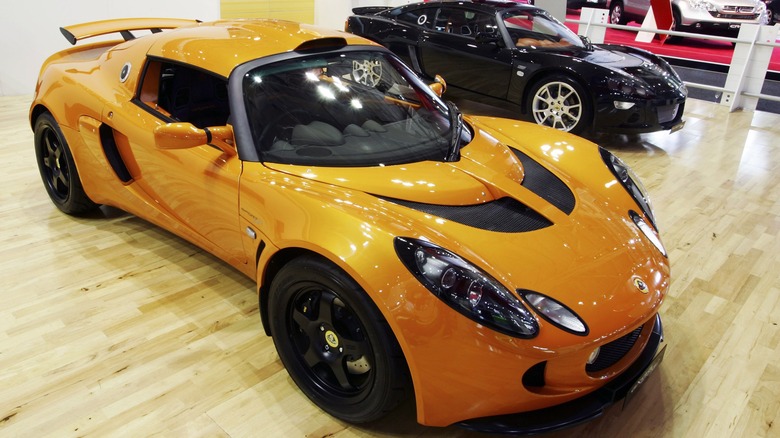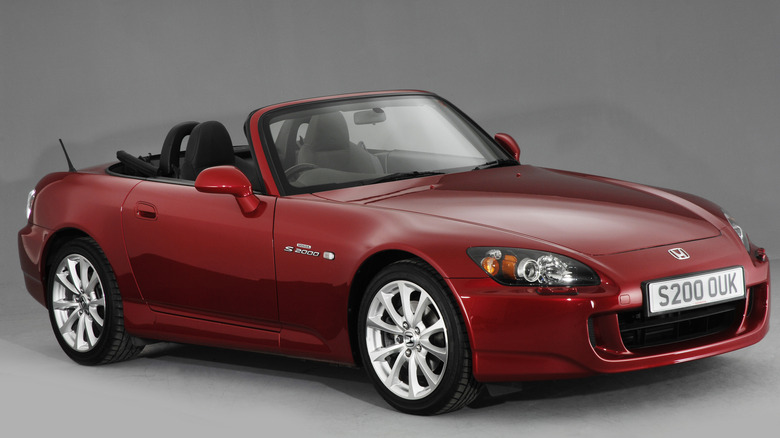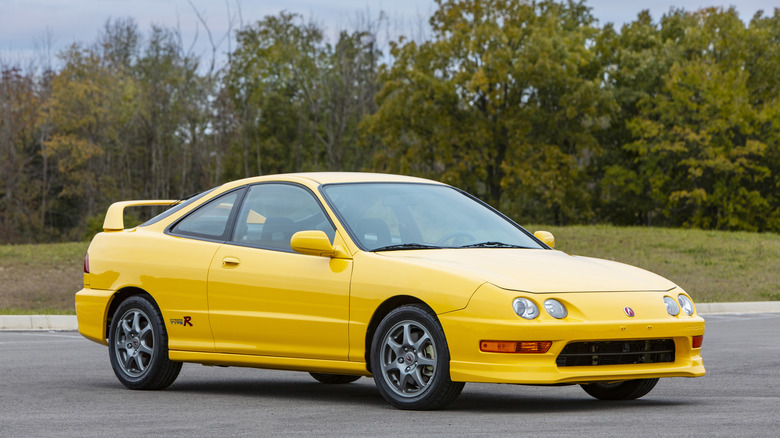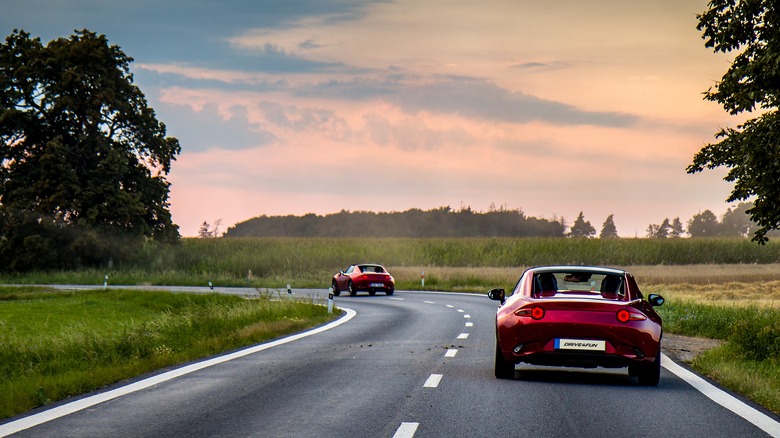10 Of The Best Four-Cylinder Sports Cars In History
The debate over what qualifies as a sports car vs a muscle car has always been pretty heated in automotive circles. On one side, you have purists who say it needs to be light and low to the ground, while others see every performance vehicle as a sports car. And that is before you start to talk about engines, where the debate is even fiercer. Can you call a thing a sports car if it only has four cylinders? Or are you in the "four-cylinder engines are only for economy cars" gang?
We think four-cylinder engines have a place in the sports car world. The models we list here all offer a driving experience that won't be matched by even some more expensive machines with six-cylinder or V8 engines. Light, always eager to turn, and plenty fast in a straight line, these machines can easily put a smile on your face. In the right hands, they might even beat a V8 sports car on a twisty road.
Do you want some of that four-cylinder recipe but can't think of any model suitable for your octane-starving needs? Worry not because every vehicle on this list has its own merit and, ultimately, is thrilling to drive. To make things more interesting, we're only including vehicles that were built as sports cars from the ground up. So they all have RWD, a lightweight chassis, and a unique appearance — cramming it with hot hatches would've been too easy, right?
Porsche 718
Porsche enthusiasts were quick to make fun of Porsche downsizing its mid-engine sports car lineup. After all, flat-six powertrains were the main differentiating factor for the Cayman and Boxster. Still, we'd argue that the lighter turbocharged flat-four 718 Cayman and 718 Boxster variants are even more fun to drive on a twisty road. They lack the sonorous nature of the six-cylinder predecessors but do sound quite good for four-cylinder engines.
They are not slow, either. The entry-level 718 Cayman and Boxster pack a 2.0-liter turbocharged engine producing 300 hp, enough to propel the lightweight sports car to 60 mph in just 4.9 seconds (4.5s with the Sport Chrono Package and PDK gearbox), with rear-wheel drive and a manual transmission!
Meanwhile, the more powerful 718 Cayman and Boxster S variants pack a 2.5-liter turbocharged flat-four unit producing 350 hp. Paired with a six-speed manual, the S variants need 4.4 seconds to reach 60 mph and have a top speed of 177 mph. The PDK versions zip away to 60 mph in just 4.2 seconds — impressive considering the number of cylinders, right?
But the straight-line acceleration is only a part of the story. Once you hit the corners, the 718 Cayman and 718 Boxster come alive. Balanced handling, sharp and direct steering, and a very playful chassis make Porsche's mid-engine cars the top pick among driving enthusiasts. And while we found the 718 Cayman GT4 more thrilling in our review, the base flat-four versions win the fun-per-dollar award.
Mazda MX-5 Miata
The most popular sports car in history has always had a four-cylinder engine, and most of its owners were fine with the performance. Yes, V6-powered project MX-5 Miatas are also popular, but if you just want to have fun on a twisty road, any regular MX-5 Miata will suffice. Mazda's roadster has the recipe for happiness: It's responsive and connects with the driver. This is an antidote to complex, heavy sports cars designed for speed rather than pleasure.
Of all MX-5 Miata generations, the latest "ND" model might just be the best. Mazda went with the tried-and-true recipe of keeping the weight and complexity down. Notably, the 2023 MX-5 Miata weighs only 2,345 pounds, with a simple but very enjoyable six-speed manual, and a non-turbocharged 2.0-liter unit producing 181 hp @7,000 rpm. Work that manual swiftly, and you'll reach 60 mph in just 5.7 seconds — not bad for an open-top RWD sports car under $30,000.
However, the MX-5 Miata has always been more about real-world experience than numbers. The vehicle provides a joyful ride thanks to its quick yet communicative steering, responsive engine, and brilliantly balanced chassis. You won't be winning any races, but few, if any, other cars will be giving you as big of a smile. Your grin won't be gone when you reach the gas station, too. With 26 miles per gallon city and 25 miles per gallon highway, the 2024 MX-5 Miata is one of the most frugal sports cars ever made.
Toyota GR86 / Subaru BRZ
While Mazda makes the best cheap open-top sports car, Toyota and Subaru share the coupe crown. Their GR86 and BRZ siblings feel a bit more grown-up, with a stiffer chassis and larger 2.4-liter engines, but still retain a big focus on driver engagement. The previous twins (the Toyota was named GT86) had 2.0-liter engines and could also put a big grin on your face, but we prefer the new ones.
The 2.4-liter naturally-aspirated boxer engine is a much more usable powerplant. It produces 228 hp @7,000 rpm and 184 lb-ft @3,700 rpm, enough for an advertised 0-60 mph run of 6.1 seconds, though real-world runs show a 5.4-second time. Crucially, the in-gear acceleration is much better — mainly thanks to the meatier torque — and the six-speed manual feels precise and mechanical.
However, the position of the flat-four engine makes all the difference here. Toyota and Subaru placed it behind the front axle for better weight distribution. Boxer engines also naturally sit closer to the ground, allowing for a much lower center of gravity. As a result, the GR86 and BRZ are sharp cornering tools, with steering precision and chassis balance that can embarrass sports cars that cost three to four times the money.
Like the MX-5 Miata, the GR86 and BRZ twins start at around $30,000. They lack the open top but they're more livable day-to-day. Between the two, choose whichever you prefer — we loved both the affordable GR86 and very fun BRZ in our reviews equally when we drove them.
Alpine A110
Europeans have always understood what sports cars are all about. Maybe it's because of the tighter winding roads or the higher gas prices of the Old World, but European sports cars have always been smaller, lighter, and sporting fewer cylinders. And one of the best-ever super-light sports cars the continent has ever produced is the Alpine A110.
This tiny and super-fun French machine packs a relatively small 1.8-liter four-cylinder turbo, which produces 252 hp in the entry-level version or up to 300 hp in the S and R versions. The A110 R is the highest-performing variant thanks to Alpine's weight-saving measures, which results in a curb weight of just 2,385 pounds. The result is a stunning 0-62 mph acceleration run of just 3.9 seconds and a top speed of 177 mph, which are supercar-beating numbers. Meanwhile, the A110 S launches to 62 mph in 4.2 seconds, and the regular A110 in 4.5 seconds.
All Alpine A110 models sadly come with a seven-speed dual-clutch gearbox, which is blazingly fast but not as engaging as a stick shift. Otherwise, the A110 has all the ingredients to be a great driver's car, with an engine that sits in the middle and drives only the rear wheels. Alpine did a great job with the suspension and steering, resulting in a very balanced and enjoyable sports car. Not surprising, as the Renault performance division competes at the pinnacle of motorsport, Formula 1!
Alfa Romeo 4C
Before Alpine resurrected itself with the A110, European and North American buyers could already buy a featherlight exotic four-cylinder sports car: the Alfa Romeo 4C. Alfa's designers did a tremendous job with the proportions and perfectly sculpted body panels here. The 4C looks like an exotic supercar — it's really a sight to behold.
Fortunately, the 4C also drives like an exotic car. The 1.75-liter four-cylinder turbo might lack the character of engines with more cylinders, but it makes up for that with ferocity and power. It produces 238 hp and 258 lb-ft of torque, enough for a 0-62 mph sprint of just 4.5 seconds. That is mainly thanks to the 1,973-pound curb weight of the European-spec coupe model, which is frankly ridiculously low. Sadly, the 4C weighs 220 pounds more in the U.S. because of crash safety standards, but even then, it's still very light.
The reason for the absurdly low weight is the carbon-tub chassis. Yup, apart from looking like an Italian exotic supercar, the 4C is also built like one. With a mid-engine RWD layout, the 4C is light, balanced, and very stiff, resulting in go-kart handling and telepathic steering response — great for enjoying a twisty road. The dual-clutch transmission is equally sharp and responsive, making a case for itself against a manual. Oh, and you can also choose between a coupe and a spider variant, both gratifying in their own way.
KTM X-Bow R
All the cars up until now were fun to drive. However, with the KTM X-Bow R, we enter "serious driving tool" territory. Sure, it's fun, but the X-Bow R is also about going supersonic on a track. An open-top carbon-fiber sports car, the four-cylinder X-Bow has the means to beat even the fastest supercars on a track. Designed to provide an uncompromised driving experience, it is as visceral as a race car, demanding full attention when driven at 100%.
Like with most track-focused sports cars, lightness is the name of the game here. Weighing just 1,742 pounds, the X-Bow R is also very rigid thanks to its carbon-fiber chassis. Furthermore, it's designed with an underbody F1-like diffusor, providing higher downforce for high-speed cornering. According to KTM, it is enough for a useful 425 pounds of downforce at 124 mph.
Unlike many track-focused sports cars today, the X-Bow R even comes with a six-speed manual gearbox, truly connecting the driver to the mechanical bits. The 2.0-liter VW-sourced turbo is also quite powerful, producing 300 hp and 310 lb-ft of torque. Use the engine and gearbox to the full potential, and a 0-62 mph sprint will only take 3.9 seconds. Impressive numbers considering the rear-wheel-drive layout and manual gearbox.
Unfortunately, in the U.S. the X-Bow R isn't street-legal, though it is in Europe. Regardless, you'll need a track either way to really explore its full potential!
Ariel Atom 3S
Did you think the KTM X-Bow R was bonkers? Well, the Ariel Atom 3S is much, much more so. It weighs just 1,450 pounds, packing a 2.4-liter Honda-sourced turbocharged four-cylinder that produces 365 hp and 310 lb-ft of torque. That means the Atom 3S is even lighter than an F1 car — imagine how responsive it is.
Ariel achieved the weight by deleting almost all creature comforts. The Atom 3S is a pure driver's car, with minimum body panels, an extra-stiff steel spaceframe, lightweight Alcon brakes, motorsport wheels, super-sticky Toyo R888R tires, and a pushrod suspension. It's the car a teenager would imagine when thinking about a Formula 1 racer for the road.
As you can imagine, the Ariel Atom 3S is a furious car. Despite packing a six-speed manual and driving only the rear wheels, this open-top race car accelerates to 60 mph in just 2.8 seconds. In-gear, it must be much faster, as the impressive 0-100 mph sprint of 6.7 seconds suggests. It would probably be like engaging warp speed. However, the way the Atom 3S gets around corners and stops might be even more impressive: The low weight and stiff chassis allow for some physics-bending grip. All of that in a four-cylinder sports car. Whacky, right?
Well, that is until you learn about the Ariel Atom 500 — a truly mad version with a 3.0-liter V8 that produces 507 hp in an even lighter 1,213-pound package.
Lotus Exige Series 2
You can't talk about lightness without Lotus. After all, its founder, Colin Chapman, once famously said, "Simplify, then add lightness." It's a moto that has been associated with almost every Lotus car throughout the brand's history, including its Formula 1 racecars. Thanks to that, the company has always been able to get away with smaller engines in its sports cars while providing similar performance to Italian supercars.
A prime example is the Lotus Exige Series 2, which packed the famous high-revving 2ZZ-GE Toyota powerplant paired with a six-speed manual. The 1.8-liter naturally-aspirated unit provides 192 hp @7,800 rpm in the entry-level model, enough for a 0-62 mph time of 5.2 seconds, thanks to the low 1,929-pound curb weight. However, the same engine in the "S" versions is supercharged, producing up to 257 hp in the Exige S 260 Sport. That particular model needs 4.4 seconds to reach 62 mph, thanks to stickier tires and an 84-pound weight reduction.
However, things get better once you turn the steering wheel. Apart from producing exceptionally light cars, Lotus is known for its chassis and suspension know-how, and that shows in the Exige Series 2. It's a very balanced sports car that, in the right hands, could be faster on a track than supercars from its era (2004-2011). Thus, while small and hard to live with, the Exige Series 2 certainly has its merit among driving purists.
Honda S2000
A high-revving engine in the front, rear-wheel drive, a slick-shifting manual gearbox, and an open top. For some enthusiasts, that's the only way a sports car should be, and the Honda S2000 is a prime example of this. It does almost everything right, despite not being received well initially.
The S2000 sits low to the ground, like a real retro sports car. It has a perfect driving position with every control close to the reach of your hands. Oh, and that six-speed manual is simply sublime. Super-precise, mechanical, and with short throws — If you have never shifted a Honda S2000 gear lever, you should put it on your shortlist.
This car is very pleasing to throw around on a twisty road. The chassis balance is impeccable, allowing you to attack any corner surgically. It's also fast, with a lateral grip similar to newer sports cars. But the crown jewels in this RWD gem are undoubtedly its naturally aspirated four-cylinder masterpieces — the very special F20C and F22C.
Depending on the production year, the Honda S2000 was offered with either a 2.0-liter or a 2.2-liter engine in North America. The larger engine came in because the 2.0-liter unit lacked torque, producing only 153 lb-ft (even though it still had an 8,900-rpm redline and 238 hp to play with). The 2.2-liter F22C bumped things up to 241 hp and 162 lb-ft of torque, though it had a lower 8,200-rpm redline. Regardless, both engines offer more character than some V6s or V8s!
Honda/Acura Integra Type R DC2
Okay, we cheated a little. We said that this list would only feature RWD sports cars, but who in their right mind wouldn't include the Honda Integra Type R DC2 in a list of the best four-cylinder sports cars? The B18C naturally-aspirated 1.8-liter VTEC unit is the centerpiece of the Integra Type R. Even without turbocharging, it produces 190 hp at a stratospheric 7,900 rpm, but even more impressive is the way this unit revs and sounds: It feels exactly like a racecar engine, which makes sense, given all the racing components it has. Those components also make it super-reliable in the long run.
That kind of power may seem low — particularly for automotive enthusiasts who weren't born when the car launched. Still, you have to remember that this front-wheel-drive sports car weighs only 2,469 pounds. As a result, the Integra Type R shoots off to 60 mph in just 6.3 seconds and reaches 145 mph. More importantly, you get to play with one of the best stick-shift transmissions in history. The five-speed manual is simply a joy to use.
If you're thinking that accelerating is where the fun ends because of the front-wheel-drive platform, you'd be wrong. Many consider the Integra Type R DC2 the best FWD sports car in history. It handles beautifully in the corners, with impeccable chassis balance and precise steering. You will always want to take the long, twisty road with the Integra Type R — it's just that good!
How did we choose these vehicles?
Lists like this one will inevitably lead to disagreements simply because there are way more than 10 great four-cylinder sports cars in history. For that reason, we excluded cars that weren't designed from the ground up as sports cars. So, performance versions of regular passenger vehicles didn't make the cut.
Other than that, it was our interpretation of what makes a good sports car, with lightness, handling, balance, and driving experience taking top priority. The engines take center stage, too, though in some cases only as a part of the overall package. Hope you liked our choices!
